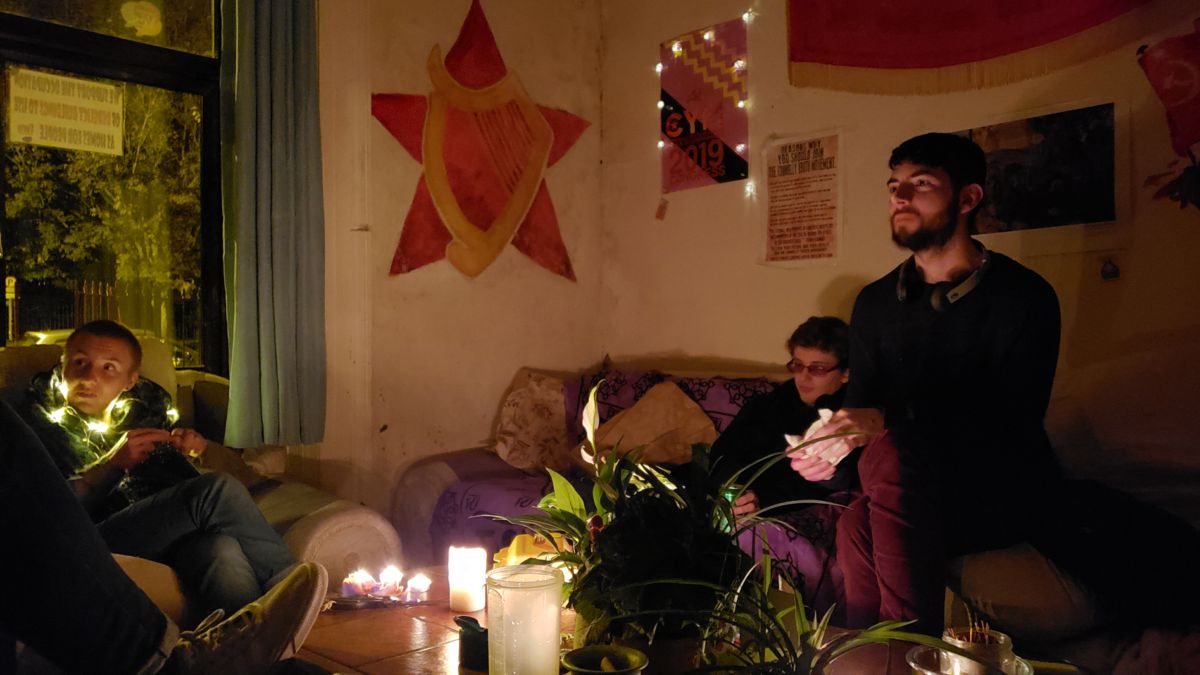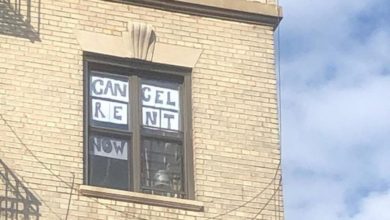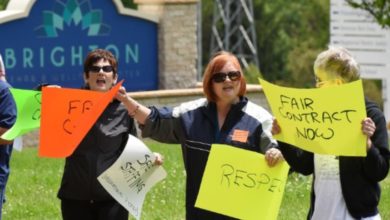 Union members and community activists block wealthy donors from entering a Schwarzenegger fundraiser. San Francisco, April 5. Photo: Bill Hackwell |
The April 5 protest took place outside a fundraiser at San Francisco’s Ritz Carlton Hotel, where people paid up to $100,000 per plate. Nurses, teachers, firefighters, and other union and community members mobilized for the demonstration.
The ANSWER Coalition put out a call to all anti-war and social justice organizations to join the action. Many members, volunteers and friends came out to support the workers’ demands. The protest surrounded the hotel and shut down the street at the entrance.
Schwarzenegger was seeking money to push through an anti-labor ballot initiative in a November 2005 special election. The governor’s campaign to privatize public employee retirement funds is closely connected to Bush’s attempts to privatize Social Security.
Privatizing public employee pensions
The $182.9 billion California Public Employees Pension Fund is the largest public pension fund in the country with 1.4 million members. The California State Teachers Retirement System is worth $125 billion. It has 750,000 members and is the third largest public retirement fund in the country.
Schwarzenegger’s privatization plan would send money for public employees’ pensions into private individual accounts held by investment firms. The change would affect all public workers hired after 2007.
Like Bush’s plan for Social Security, money for workers’ retirement would go directly into the stock market. This would make corporate bosses richer today, but provide no future guarantee of pension payments. Workers would be dependent on how much money their stock market investments returned.
Series of attacks on workers
The pension privatization campaign is only one part of Schwarzenegger’s overall program to enrich big corporations and roll back workers’ rights.
Last November, the Governor attempted to change parts of the current law mandating a low nurse-to-patient ratio in hospitals by “emergency” regulation. The law was designed to ensure a safe ratio to protect patients and make sure nurses weren’t overworked.
The California Nurses Association quickly reacted to Schwarzenegger’s move. The union held a major rally of more than 2,500 nurses at the capitol in Sacramento on Dec. 1, 2004. In response to protesting nurses, Schwarzenegger called them “special interests” and said they did not like him because “I kick their butt.” The movement to protest Schwarzenegger started gathering steam.
His next attack on California workers was another “emergency” regulation, this time aimed at taking away workers’ lunch breaks. Pressure from labor unions and workers of all ages forced the governor to rescind the regulation quickly.
Then, in January 2005, he launched a campaign to privatize public employee pensions. Although he has withdrawn this proposal, Schwarzenegger is still trying to sell an initiative linking teachers’ pay to “merit” rather than seniority. This would weaken teachers’ unions.
Schwarzenegger is also calling for greater power to push through budget cuts in social services. Last year the Governor’s budget borrowed $2 billion from schools. The money has not been returned to education funding this year, in violation of California law.
The CNA has held nearly 40 protests against the governor so far, often teaming up with the California Teachers Association. A growing coalition of labor also has joined the protests in recent months.
‘Union power’
In weeks leading up to the April 5 protest, thousands of workers confronted the governor at fundraising events in Los Angeles, San Jose and other cities. The protests became increasingly militant. The CTA and CNA began running major ad campaigns against Schwarzenegger’s policies in the mass media.
Workers at the April 5 protest broke through police lines and shut down the street at the hotel’s entrance for over one hour. Limousines dropping off rich donors were trapped and surrounded by angry workers chanting, “Who’s got the Power? We’ve got the Power! What kind of power? Union power!” and “Corporate Scum!”
Each time police tried to bring rich donors through the crowd to the door, nurses, teachers and firefighters blocked the path with their bodies. Workers were pushed back by the police only to advance again. Many of the millionaire donors were clearly shaken by the experience.
Handing the right wing a defeat
On April 7, two days after the demonstration, Schwarzenegger announced he was halting his campaign to privatize pensions through the November ballot initiative. He said he might still attempt to include privatization on the June 2006 ballot.
The same day, his petition to increase the nurse-to-patient ratios was denied by the California Court of Appeals.
California’s public pension funds are a key battlefront in the workers’ struggle against the banks and corporate bosses. If these pension funds are privatized, the Bush administration’s campaign to privatize Social Security and pensions across the country would be strengthened. Workers are showing they’ll fight to make sure that doesn’t happen.
Schwarzenegger wouldn’t have pulled back without the militant mobilization by rank and file union members. Although it is not yet a complete victory, it is an important step forward, made possible only by the workers demonstrating their power.






